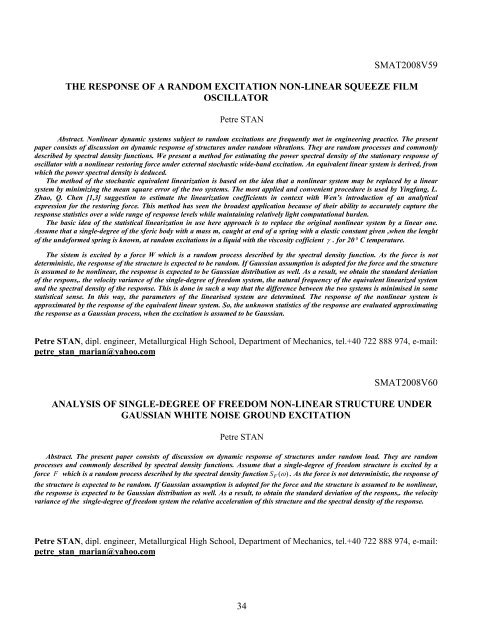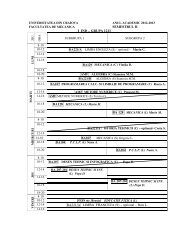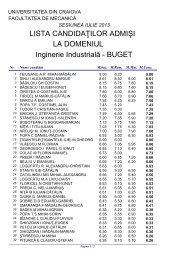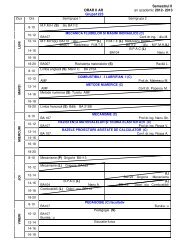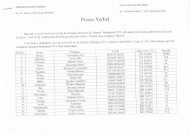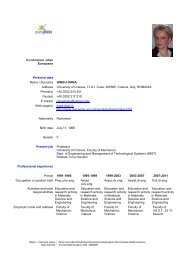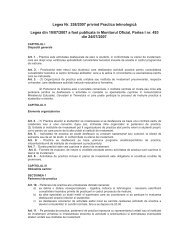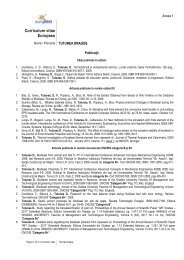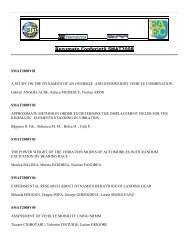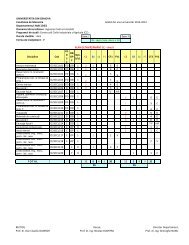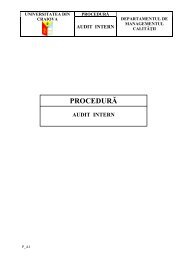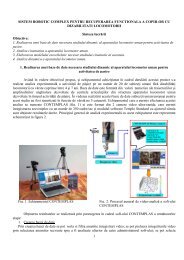Instructions for Authors - Facultatea de Mecanica Craiova ...
Instructions for Authors - Facultatea de Mecanica Craiova ...
Instructions for Authors - Facultatea de Mecanica Craiova ...
You also want an ePaper? Increase the reach of your titles
YUMPU automatically turns print PDFs into web optimized ePapers that Google loves.
SMAT2008V59THE RESPONSE OF A RANDOM EXCITATION NON-LINEAR SQUEEZE FILMOSCILLATORPetre STANAbstract. Nonlinear dynamic systems subject to random excitations are frequently met in engineering practice. The presentpaper consists of discussion on dynamic response of structures un<strong>de</strong>r random vibrations. They are random processes and commonly<strong>de</strong>scribed by spectral <strong>de</strong>nsity functions. We present a method <strong>for</strong> estimating the power spectral <strong>de</strong>nsity of the stationary response ofoscillator with a nonlinear restoring <strong>for</strong>ce un<strong>de</strong>r external stochastic wi<strong>de</strong>-band excitation. An equivalent linear system is <strong>de</strong>rived, fromwhich the power spectral <strong>de</strong>nsity is <strong>de</strong>duced.The method of the stochastic equivalent linearization is based on the i<strong>de</strong>a that a nonlinear system may be replaced by a linearsystem by minimizing the mean square error of the two systems. The most applied and convenient procedure is used by Yingfang, L.Zhao, Q. Chen [1,3] suggestion to estimate the linearization coefficients in context with Wen’s introduction of an analyticalexpression <strong>for</strong> the restoring <strong>for</strong>ce. This method has seen the broa<strong>de</strong>st application because of their ability to accurately capture theresponse statistics over a wi<strong>de</strong> range of response levels while maintaining relatively light computational bur<strong>de</strong>n.The basic i<strong>de</strong>a of the statistical linearization in use here approach is to replace the original nonlinear system by a linear one.Assume that a single-<strong>de</strong>gree of the sferic body with a mass m, caught at end of a spring with a elastic constant given ,when the lenghtof the un<strong>de</strong><strong>for</strong>med spring is known, at random excitations in a liquid with the viscosity cofficient γ . <strong>for</strong> 20 0 C temperature.The sistem is excited by a <strong>for</strong>ce W which is a random process <strong>de</strong>scribed by the spectral <strong>de</strong>nsity function. As the <strong>for</strong>ce is not<strong>de</strong>terministic, the response of the structure is expected to be random. If Gaussian assumption is adopted <strong>for</strong> the <strong>for</strong>ce and the structureis assumed to be nonlinear, the response is expected to be Gaussian distribution as well. As a result, we obtain the standard <strong>de</strong>viationof the respons,. the velocity variance of the single-<strong>de</strong>gree of freedom system, the natural frequency of the equivalent linearized systemand the spectral <strong>de</strong>nsity of the response. This is done in such a way that the difference between the two systems is minimised in somestatistical sense. In this way, the parameters of the linearised system are <strong>de</strong>termined. The response of the nonlinear system isapproximated by the response of the equivalent linear system. So, the unknown statistics of the response are evaluated approximatingthe response as a Gaussian process, when the excitation is assumed to be Gaussian.Petre STAN, dipl. engineer, Metallurgical High School, Department of Mechanics, tel.+40 722 888 974, e-mail:petre_stan_marian@yahoo.comSMAT2008V60ANALYSIS OF SINGLE-DEGREE OF FREEDOM NON-LINEAR STRUCTURE UNDERGAUSSIAN WHITE NOISE GROUND EXCITATIONPetre STANAbstract. The present paper consists of discussion on dynamic response of structures un<strong>de</strong>r random load. They are randomprocesses and commonly <strong>de</strong>scribed by spectral <strong>de</strong>nsity functions. Assume that a single-<strong>de</strong>gree of freedom structure is excited by a<strong>for</strong>ce F which is a random process <strong>de</strong>scribed by the spectral <strong>de</strong>nsity function SF( ω ). As the <strong>for</strong>ce is not <strong>de</strong>terministic, the response ofthe structure is expected to be random. If Gaussian assumption is adopted <strong>for</strong> the <strong>for</strong>ce and the structure is assumed to be nonlinear,the response is expected to be Gaussian distribution as well. As a result, to obtain the standard <strong>de</strong>viation of the respons,. the velocityvariance of the single-<strong>de</strong>gree of freedom system the relative acceleration of this structure and the spectral <strong>de</strong>nsity of the response.Petre STAN, dipl. engineer, Metallurgical High School, Department of Mechanics, tel.+40 722 888 974, e-mail:petre_stan_marian@yahoo.com34


